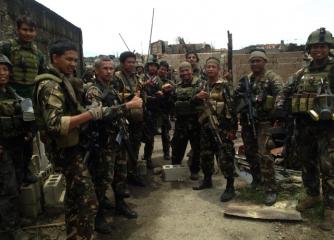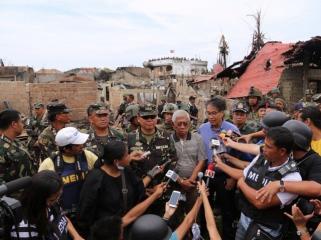Posted to Bulatlat (Sep 28): The poet is a guerrilla
The guerrilla is like a poet Keen to the rustle of leaves The break of twigs The ripples of the river The smell of fire And the ashes of departure. – Jose Maria Sison, 1968 Sari and Kiri Dalena’s ground-breaking film, The Guerilla is a Poet, takes its inspiration from Communist Party of the Philippines (CPP) Founding Chairman Jose Maria “Ka Joma” Sison’s well-known poem “The Guerilla is Like a Poet.” As Prof. Sison points out in the film, the poem was the fruit of his imagination, having been written even before he and Bernabe “Ka Dante” Buscayno founded the New People’s Army (NPA) in March 1969.
The film’s depiction of revolution in the Philippine setting and life in the revolution is in the same way described, but in a figurative manner, in Prof. Sison’s prescient poem wherein the guerilla fighter at the forefront of “the people’s war” is likened to the poet writing on the same theme and both, in so doing, creatively giving life to “the people’s epic” of revolution.
The poem itself is a testament to the human element — the “humanity” — in waging a people’s war. Objectively speaking, war, even one with a just cause, can be dehumanizing. Thus the usual portrayal of the guerilla is that of a hardened person inured to his harsh surroundings, incapable of emotions and of the appreciation of the finer things in life such as art and poetry. Prof. Sison’s poem departs from and negates this depiction.
Underlying the entire film showing the life and times of Filipino revolutionaries, particularly Joma, Juliet “Ka Julie” de Lima, and Dante et al, is their being human. The film not only shatters the stereotypic “G &D” (grim-and-determined) image of activists and revolutionaries but also discloses their humanity as the basis for their “iron will,” i.e. their preparedness and capacity to endure hardships and sacrifices.
The film does so on many levels: (1) the revolutionaries are depicted as human with the same needs and concerns and even foibles as ordinary human beings; (2) they have a deep love for humanity, most especially the most exploited and oppressed; (3) they strive to overcome their own human limitations and frailties and commit to fight for radical changes in society; (4) they do not lose their humanity, i.e. their love and concern for others, but rather enrich and fully develop it in the course of struggle. While engaging in revolutionary struggle, they consciously and unconsciously become better human beings just as a poet hones his craft as he continues to engage life and to mirror it in his writing.
It is certainly a measure of the quality of the acting that this message was imparted to the audience in a most natural and convincing manner.
The film is also the biopic of the Philippines’ foremost revolutionary leader, Jose Maria Sison and rightly so. Ka Joma personifies the modern-day Philippine revolution that is the inheritor of the unfinished revolution of Andres Bonifacio and the Katipunan. His life story incorporates and reflects all of the major events, the twists and turns as well as the ebbs and flows of the revolutionary movement. And, yes, Prof. Sison, the prize-winning poet, was also a guerilla in his younger years, before his capture in 1977.
The film masterfully combines the dramatization of events, interviews with the key real-life actors on the historical stage — Joma himself, Julie and Dante — and haunting music of the iconic revolutionary songs of the late 1960s and ’70s. The former depicts the history of the revolution and highlights its landmarks: Sison’s development as an activist, a trade union leader and a revolutionary theoretician; Sison’s interactions with Senator Benigno Aquino; the founding of the CPP; Sison’s meeting with Buscayno and the founding of the NPA; the Plaza Miranda bombing and Marcos’ declaration of martial law; workers, students and former soldiers joining the underground resistance; the painstaking work of organizing the peasants in the countryside and expanding and strengthening the NPA; setbacks with the arrest, torture, and killing of CPP cadres and NPA commanders; the Sison couple’s capture (including the account of the Dictator Marcos’ dialogue with Sison before the latter is subjected to interrogation, torture and prolonged solitary confinement).
The film ends with the couple’s exile in the Netherlands where they continue to actively engage in the revolutionary struggle in the Philippines through their writings and interviews, the on-and-off GPH-NDFP peace negotiations and international solidarity work.
The film’s format — acting by seasoned as well as neophyte actors interspersed with narration by the real Joma, Julie and Dante — is so efficacious, one without the other would have been inadequate and less compelling.
Joma Sison is the principal storyteller, weaving his own recollections of historical events, highlighting their significance and giving his insights. In the beginning of the film, Joma is shown humming a tune as the car wends its way through the streets of Utrecht. At some point he sings an unfamiliar song of the pioneering national democratic youth mass organization he founded in 1974, the Kabataang Makabayan. Then he concludes emphatically that without these revolutionary songs, the expansion of the movement would not have been as rapid, for who would memorize long political speeches while everyone can learn to sing a revolutionary song.
The narrations by the real Joma, now 74, show him to be full of banter, cheerful, making light of torture, brimming with optimism. Those who knew and worked with the younger Joma would attest to the fact that this is the same 29-year-old Joma who led the reestablishment of the party that was needed to lead the revolution, with seemingly boundless imagination, enthusiasm, energy, passion and zest for revolution.
Guerrilla is a Poet captures and builds on the essence of the poem’s verse — the blending of the human subjective factor with the objective natural and social environment; thus the guerilla is “well versed on the law of motion, master of myriad images.” This is the key to how the guerilla — small, weak, and initially inferior to the enemy, survives, gains strength, and gradually weakens the enemy by waging a people’s war based on a concrete analysis of concrete conditions, “moving with the green brown multitude, in bush burning with red flowers…”
Mao, in his treatise expounding on how the Chinese people could overcome the militarily superior Japanese aggressors through a protracted people’s war, similarly used poetic language in describing how in his endeavor to win a war “… a military strategist cannot overstep the limitations imposed by the material conditions; within these limitations, however, he can and must strive for victory. The stage of action for a military strategist is built upon objective material conditions, but on that stage, he can direct the performance of many a drama, full of sound and color, power and grandeur.”
The Guerilla is a Poet is truly successful in giving the audience a glimpse of the drama, sound and color, power and grandeur of the launching and early years of the “the people’s epic, the people’s war.”
By Carol Pagaduan-Araullo Streetwise | BusinessWorld
Published in Business World September 26, 2013
http://bulatlat.com/main/2013/09/28/the-poet-is-a-guerrilla/
The activity was aimed to further enhance the ability of the participants to facilitate whatever activities they will handle in their respective organizations in line with their common goal, to bring change in the communities of the Bangsamoro people.
Select young professionals, student leaders and out of school youth who are active in their organizational undertakings comprised the delegates.
Anwar Upahm, Executive Director of Coordinating and Development Office on Bangsamoro Youth Affairs of the Autonomous Region on Muslim Mindanao (ARMM) government, handled inputs on leadership.
He discussed the requirements for an effective leader which include knowledge in Islam, good moral character and good communication skills.
Upahm also outlined the Holy Prophet’s leadership characteristics as follows: Knowledgeable, just, sublime moral character, generous, courteous, forgiving, cautious, diplomatic, humble, keep promises and able to supervise subordinates.
Also an active advocate of justice and peace, Upahm urged the young Moro leaders to bring development in their community through sharing their skills and motivating fellow youth to become productive young citizens of the country.
Edgardo B. Ramirez, the main training facilitator, handled the topics on discussion, planning and workshop methods. He also saw to it that the participants were able to share their inputs.
Upahm reminded the delegates that “A leader is also a facilitator, motivator and planner” and pointed out that “Leader should also be consultative as well as participative.”
The activity was hosted by CDO-BYA and ARMM Development Academy.
http://www.luwaran.com/index.php/welcome/item/580-young-moro-leaders-undergo-training-on-facilitation











